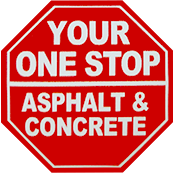How Water Damages a Surface
Let’s say your area gets a big thunderstorm that dumps around 1 inch of rain. What does this rain do to paved surfaces, mechanically speaking? Asphalt is made of oil-based materials and oil is lighter than water, so any water that can seep into cracks and pores in the asphalt will push the protective oils out of and away from the road surface. If the road is purely concrete, water soaks into pores and crevices in the material. In either case, when the water is heavy enough to create streams, those streams carry any loose granules away from the paved area.
Individually, this process doesn’t seem like a big deal, but over time, the long-term impact can result in the need for costly repairs. For example, the St. Louis area gets an average of 43 inches of rain a year, which is about 0.8 inches per week. Every quarter inch of rain will remove around 1 pound of solid material and up to a pound of oil per 100 square feet of asphalt or concrete. This means that every week, the paved surface is losing about 6 pounds of material per 100 square feet. To put that into perspective, the average width of roadways in the U.S. is right around 100 feet, so for every foot of roadway, about 6 pounds of granules and oil are removed weekly.
As the granules get beaten out of the roadway by passing cars and washed away by rain, the surface becomes more porous and brittle, resulting in the surface wearing down faster. When the oil is removed, the surface becomes less water resistant and more prone to water erosion.
Not only can water cause surface damage, but can also cause problems underneath due to major erosion from flooding and water flowing under the roadway. Large amounts of water can take out material under the pavement and cause soft spots, especially in roads and parking lots made entirely of asphalt.
Problems can also arise if a paved surface has been poorly designed, or cracks and breakdown allow water to get in, resulting in the water expanding and contracting with the weather. Concrete can expand and contract so much that if there isn’t enough space in the expansion joints, the sections of concrete will crash into each other with such force that it will pulverize the joints into powder. On the other hand, water can lift sections of roadway in cold conditions due to ice formation, cause bubbles and pockets to form in asphalt in hot conditions, and cause the surface to wear and crumble in any condition.
Water will seep into every nook and cranny it can find. If there is water in the roadway and the temperature becomes extremely hot, the water will turn to vapor and steam and can actually cause intense damage to the tar as it escapes into the air. If it becomes extremely cold and the water freezes, the ice will expand where it is and break cracks and holes into the surface. When the ice melts again, it will settle deeper into those cracks and possibly refreeze, breaking it apart even more.
How to Prevent Water Damage
Here at A1 Professional Asphalt and Sealing, we have many years of experience designing solutions that will slow and even halt these destructive natural processes. We know how to keep your paved surface looking great and crack-free for years to come.
We offer many materials and mixes for your needs, whether for a new installation or repair and resurfacing of current pavement. Our preventive maintenance includes oil sealing and tarring, which are necessary to keep water out. Periodic repaving will help keep the material compacted and looking great for years to come.
Our team is highly trained to provide the highest quality service available, and we strive to keep our work looking great for decades. Give us a call and we will help walk you through the entire process from initial design to yearly upkeep and maintenance.
Don’t let water destroy your investment – Contact us today!

